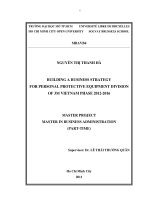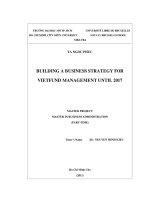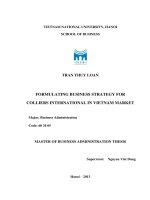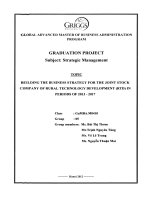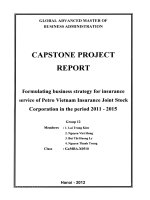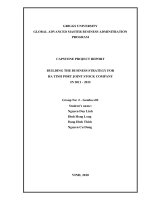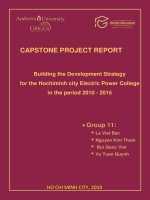Building the business strategy for logistics service in Viet Nam ocean shipping Joint stock company - vosco period of 2014 - 2018
Bạn đang xem bản rút gọn của tài liệu. Xem và tải ngay bản đầy đủ của tài liệu tại đây (1.65 MB, 90 trang )
BUILDING THE BUSINESS STRATEGY FOR
LOGISTICS SERVICE IN VIET NAM OCEAN
SHIPPING JOINT STOCK COMPANY – VOSCO
PERIOD OF 2014 – 2018
CAPSTONE PROJECT REPORT
Ho Chi Minh City, 2013
Group 02:
Doan Thi Hang
Vu Minh Hien
Tran Quyet Thang
Dang Thi Dieu Lien
Class: Ga.MBA C0112
Capstone Project Report – Ga.MBA01.C0112 – Group 02
Page i
ACKNOWLEDGEMENT
Firstly, we would like to express our sincere thanks to the Professors, The
teachers of GRIGGS University, The Center for Educational Technology and
Career Development (ETC) - Vietnam National University who have
enthusiastically instructed us during the MBA course and our research.
Especially thanks to the Board of Management and all the staffs in Vietnam
Ocean Shipping Joint Stock Company for help during our accomplishing this
assignment. The intimate, candid exchanges and seminars in your company help us
to have a realistic look and analytical data in accomplishing this topic “Building the
business strategy for logistics service in Vietnam Ocean Shipping Joint Stock
Company, period of 2014 - 2018”.
Group 02 – C0112 included 04 members who come from Interni Forwarding
Company, Vietcombank, Saigon New Port and Vosco decided to research the topic:
”Building the business strategy for Logistics service in Vietnam Ocean
Shipping Joint Stock Company, period of 2014 – 2018” as the respectful gift to
express our sincere thanks to all the Professors, all the Teachers of Griggs Andrew
University who provided us the valuable skills and knowledge during the course of
Master of Business Administration.
Ho Chi Minh City, Sep 2013
Group 02 – C0112
Capstone Project Report – Ga.MBA01.C0112 – Group 02
Page ii
INDEX
Content Page
Acknowledgement: i
Index: ii
Categories symbols and abbreviations vi
Model, table vii
Chart viii
Introduction ix
CHAPTER 1 : THE THEORY OF BUILDING THE BUSINESS STRATEGY FOR
LOGISTICS SERVICE 1
1.1 The concept of business strategy 1
1.1.1 The definition 1
1.1.2 The kinds of business strategies: 1
1.1.2.1 Enterprise strategy : 1
1.1.2.2 Business strategy: 1
1.1.2.3 Functional strategy: 2
1.1.2.4 Global Strategy 2
1.1.3 The strategy‟s basic rules 2
1.1.4 The roles of business strategy : 3
1.2 Planning the business strategy: 4
1.2.1 The external environment analysis : 4
1.2.1.1 PEST Model analysis : 4
1.2.1.2 M Porter 5 forces model: analysis the factors in the business environment
effected to the enterprise‟s business. : 6
1.2.2 Analyzing the external environment : 7
1.3 The tools of building and implementing the business strategies. 9
Capstone Project Report – Ga.MBA01.C0112 – Group 02
Page iii
1.3.1 EFE matrix 9
1.3.2 IFE matrix 10
1.3.3 Competitors Profile Matrix 11
1.3.4 SWOT Matrix 11
1.3.5 QSPM matrix 13
CHAPTER 2 : VOSCO‟S SITUATION ANALYSIS 15
2.1 Vietnam Ocean Shipping Joint Stock Company „s general view 15
2.1.1 The history: 15
2.1.2 The current services : 16
2.1.3 The company‟s business situation : 16
2.1.4 Current Situations of Logistics Business 17
2.1.5 Customer, logistics service and branch : 18
2.1.6 Result of operation activities: 20
2.1.6.1 Revenue Target : 21
2.1.6.2 Expense target 21
2.1.6.3 Revenue target : 23
2.2 Analyzing the external factors : 23
2.2.1 The macro environment factors – PEST MODEL: 23
2.2.1.1 Economic Factors 25
2.2.1.2 Social and Culture Factors 27
2.2.1.3 Scientific, technical and technology environment factors 27
2.2.2 Competitive Factors Analysis (5 Forces M. Porter) : 28
2.2.2.1 Threats of new entrants (highest) 28
2.2.2.2 Bargaining power of buyers : 29
2.2.2.3 Bargaining from the suppliers 29
2.2.2.4 Threats of substitute products (normal) 30
2.2.2.5 Competitive Rivalry : 31
Capstone Project Report – Ga.MBA01.C0112 – Group 02
Page iv
2.3 Internal Enterprise analysis : 38
2.3.1.1 Human Recourses 38
2.3.2 Marketing abilities: 40
2.3.3 Technology Abilities : 41
2.3.4 Financial Capability: 41
2.3.4.1 The situation of production and business activities : 41
2.3.4.2 Analysis of balance sheet : 43
CHAPTER 3 : CHOOSING AND BUILDING THE BUSINESS STRATEGY OF
LOGISTICS SERVICES FOR ENTERPRISE IN PERIOD OF (2014-2018) 55
3.1 Enterprise‟s Mission : 55
3.2 The logistics strategies : 56
3.2.1 The solution of Business strategy with SWOT matrix : 56
3.2.2 Choosing the optimum strategy base on the QSPM matrix 60
3.2.2.1 Financial Solutions : 62
3.2.2.2 Restructure solution : 64
3.2.2.3 Technology & procedure solutions 65
3.2.2.4 Technology & procedure solutions 66
3.2.2.5 Marketing solution : 69
3.2.2.6 Traffic solution 71
CONCLUSION 73
Capstone Project Report – Ga.MBA01.C0112 – Group 02
Page v
CATEGORIES SYMBOLS AND ABBREVIATIONS
AS : Attractiveness Scores
APEC : Asia Pacific Economic Cooperation
CSCMP : Council of Supply Chain Management Professional
ISM CODE : International Safety Management Code
LSP : Logistics Service Provider
SCM : Supply Chain Management
SQEMS : Safety Quality and Environmental Management System
TAS : Total Attractiveness Scores
VOSCO : Vietnam Ocean Shipping Joint Stock Company
VIFFAS : Vietnam Freight Forwarders Association
VITRANSS2 : Vietnam Transportation Sustanable Development Project
WTO : World Trade Orgnization
Capstone Project Report – Ga.MBA01.C0112 – Group 02
Page vi
CHART , TABLE
Model 1.1: Overall business strategy model 4
Table 1.1: SWOT matrix 13
Table 1.2 : QSPM form 14
Model 2.1 : Company organization chart 15
Model 2.2 : Vosco„s logistics operation model 16
Table 2.1: Summary of operation results from 2010 to 2012 17
Table 2.2 : Domestic logistics account list 18
Table 2.3 : The market share of domestic container transportation 19
Table 2.4 : Data of logistics service in the domestic business 20
Table 2.5 : The proportion of operating costs on net revenue: 21
Table 2.6 : CPM matrix 33
Table 2.7 : The survey of EFE results 34
Table 2.8 : The result of evaluation of EFE 36
Table 2.9 : EFE matrix 36
Table 2.10 : VOSCO‟s human resources statistic 38
Table 2.11: The machines list 39
Table 2.12 : The warehouse facilities list 39
Table 2.13 : The years of ship list 41
Table 2.14 : Report of Cash Flow 41
Table 2.15 : Consolidated Balance Sheet 43
Table 2.16 : Financial indicator Group: 45
Table 2.17 : The survey of Internal Factors 50
Table 2.18 : Internal factor survey result 52
Table 2.19: the matrix of evaluation of IFE 52
Table 2.20 SWOT analysis 53
Table 3.1: SWOT matrix of combination 56
Table 3.2 : Choosing the strategy as QSPM matrix 60
Tabble 3.3: The planning of revenue: 63
Table 3.4 The planning of cost: 63
Capstone Project Report – Ga.MBA01.C0112 – Group 02
Page vii
CHART
Chart 2.1 : The domestic container transportation‟s market share 19
Chart 2.2 : Revenue of logistics services 21
Chart 2.3 : Comparison of depreciation cost and administration cost 22
Chart 2.4 : Profit after tax of Logistics Services business 23
Chart 2.5 : Enterprise Asset Situation 47
Chart 2.6 : Capital resource 48
Capstone Project Report – Ga.MBA01.C0112 – Group 02
Page viii
INTRODUCTION
I. The introduction
Shipping transportation is one of the important links in the logistics supply
chain. Since 2014, as the commitment joining WTO, the foreign enterprises have
the right to invest 100% foreign capital in Vietnam, so the Vietnamese logistics
enterprises will be facing the fierce competition. There are about 900 logistics
companies with different scales in Vietnam now, in which 70 to 80% are small and
medium scales. According to Mr. Nguyen Cam Tu – Deputy Minister of Industry
and Trade said “ the potential of logistics development is even greater as our
trading turnover considered as the country‟s fastest growth rate in the region with
speed of 18 to 20 % per year and turnover nearly reached usd130 billion. However
the same with the other developing countries in the region, the logistics business in
Viet Nam are mainly small and medium enterprises, so the business structure is
fragmented, non-professional and limited human recourse.
Mr. Bui Ngoc Hoan – The Chairman of Freight Forwarders Association
Vietnam (VIFFAS) said: "About 90% of export import goods in Vietnam are
transported by sea. However, the Vietnam fleet covered about 18-20% of the
transported goods. The total volume of export import cargo in Vietnam in 2007
was 181.12 million tons, in which containerized cargo was 49.29 million tons
(4,489,165 TEUs). Multimodal Transportation is an important factor of logistics
services in Vietnam shipping plays a very important role in the strategy of
developing the logistics services in Vietnam”
Therefore, the logistics services sector has played a very important role in
Vietnamese economic development in general and maritime industry in particular.
With the hope of contributing our efforts to our country‟s logistics service
development, by the knowledge gained from the lesions in the program Global
Advanced Master of Business Administration C0112, the exchange experiences
learned from the partners in Asian (Japan, China, Singapore…) and EU (Holland,
Germany, Belgium…) as well as in the daily works, our group members come
Capstone Project Report – Ga.MBA01.C0112 – Group 02
Page ix
from Saigon New Port, Vietcombank, Interni Logistics Company and Vosco
decided to research the topic : „’Building the business strategy for logistics
service in Vosco JSC, period 2014 – 2018”.
According to Dr. Nguyen Van Chuong – The Deputy Director of Vietnam
Transportation Strategic Development Institute‟s said: “Vietnam has actually
entered the WTO, as the other manufacturing business sectors, the transport sector
in general and the marine transport industry in particular has changed positively to
improve their competitiveness, the service quality and efficiency. There are some
important directions in this process is the expansion of logistics services and value
added services in the supply chain”.
The Vietnamese enterprises in general and Viet Nam Ocean Shipping JSC in
particular have to strengthen and expand the logistics services and value added
services in the supply chain, as well as promote the strategy of logistics business in
the period of fierce competition with participating of 100% foreign capital
companies in the process of integration WTO.
In order to building the effective solutions in the field of logistics service in general
and in Viet Nam Ocean Shipping JSC – VOSCO in particular, firstly, we would like
to introduce the concept of logistics, the concepts of supply chain as well as the
roles of the stakeholders in the supply chain.
1. The concept of Logistics:
In fact, the term “logistics” already had two centuries ago, considered to
have originated in the military‟s need to supply itself with arms, ammunition and
rations as it moved from a base to a forward position. So far, this term referred to in
English as „logistics‟ and widely used in a lot of fields to specify many diverse
activities, focus on providing the correct amount of fuel needed, at the right time
and in the right places. As the settlement of the transportation, storage or
commercial production and logistics services of different companies in each way or
another, so there are a lot of definitions of „‟logistics‟‟as The Council of Supply
Chain Management Professionals (CSCMP) : „‟Logistics management is a part of
Capstone Project Report – Ga.MBA01.C0112 – Group 02
Page x
supply chain management that plans, implementation and delivery flow control,
storage of goods, services and information between the starting point and the ending
point is the initial consumer yield and efficiency, in order to meet the customer‟s
requirements”. But in this definition: it is not only for the consumer goods flow but
including the services with the main purpose to satisfy the customers‟ requirement;
it means the reasonable cost for the cargo services.
Following the development of the productive forces and the active supports of the
revolution in the field of science and technology in the world, the volume of cargo
and material products increasing and the distance in the field of traditional
competition as the product quality or price dwindling, the manufacturers have
switched to the competition of inventory management, speed of delivery, the flow
of raw material and semi – finished products… in the management system of
physical distribution. Logistics services have the opportunity to develop powerful in
the business.
In the field of military, logistics is defined as the science of planning and carrying
out the movement and concentration of forces the military operations related to
the design and development, acquisition, storage, movement, distribution,
concentration of ammunition and equipment.
On the other hand, according to the Vietnamese Trade Law of 2005 (Article 233):
In the Vietnamese Trade Law of 2005, it is the first time that the concept of logistics
services are codified. Logistics services are the commercial activities whereby
traders implementation of one or more processes including receiving, shipping,
storage, warehousing, customs clearance, the paper procedures other documents,
client consultation, packaging, and mark, delivery or other services relating to
goods as agreed with the customer to remuneration. "
2. The concept of Service Supply Chain (as known as Supply Chain
Service):
According to the American Council of Supply Chain Management Professional
Capstone Project Report – Ga.MBA01.C0112 – Group 02
Page xi
CSCMP (www.cscmp.org) , the Logistics Chain Management – Logistics Supply
Chain is;” Supply Chain management includes the planning and management of all
involved activities in sourcing and the acquisition, conversion and all logistics
management activities, it is important that it includes the collaboration and
combined by the partner channels, the partner can be the suppliers, the
intermediaries , the third suppliers and the customers. In the essence, the supply
chain management combines with the supply and demand management in the
companies
In this definitions: the scope of supply chain management (SCM) is the expanding of
Logistics (Logistics): SCM also is about the source (around the world) and the
procurement of raw materials, where production etc ; SCM optimizes the flow of
goods not only in the company and also between companies; SCM promotes the
cooperation of companies (independent) and the cooperation, which combines the
approach of many activities, from product design to consumer stage (and even
higher is the reproduction of the product used)
Since the above definitions we can see: Logistics service includes the processes of
importing fuels, inputting materials for production processes, goods production and
distribution channels to the consumers. It help to separate the individuals suppliers
as transport services, forwarding, customs clearance, distribution, manufacturing
support service, management consulting….
Since then, the logistics concept is understood in a broad sense; it is always
associated with the concept of supply chain logistics services logistics and is built
basing on the implementation cycle. Logistics service Supply chain as launched
and presenting in the flow chart below:
Capstone Project Report – Ga.MBA01.C0112 – Group 02
Page xii
3. The role of the stakeholders in the Logistics Service Supply Chain
In the above supply chain flow chart the stakeholders includes: The
Government, The Shippers, The manufacturers and business, the logistics service
providers and the consumers…
* Shippers: be understood in a broad sense (not just in terms of ownership),
including the following subjects: The manufacturers, the suppliers (export import
trading companies); the wholesalers, the retailers, the consignors, the consignees…
* The logistics service providers include:
The freight carriers, the shipping lines, the air lines, the trucking companies, the
warehouses firms, the freight forwarders, the third party logistics…
* The Logistics Service Providers: In order to minimize the logistics cost
(transport cost, data processing cost…) to meet the customer‟s demand.
* The consumer: They want to maximize their demand of consumer goods with
the reasonable prices and the goods price is one of the sectors that effected to the
consumers‟ satisfaction and it‟s important that they spend much for the good
quality goods and delivery on time. But the consumers have affected by the traffic
jam and the environment pollution so they hope that these problems will be solved.
* The Government: having responsibility to maximize the social‟s interest (the
total social interest – the total social cost). The Government‟s intervention made
the potential resource having equal distribution as well gaining the highest result
and sustainable development for logistics service.
The shipping lines participated in one stage of supply chain in case of providing
the cy to cy contract for transportation and the same situation for the airlines and
rail transportation.
Capstone Project Report – Ga.MBA01.C0112 – Group 02
Page xiii
II. The research objective and scope :
1. The research subject and scope
- Topic: Building the business strategy for logistics service in Vosco, period of
2014 – 2018.
- Scope: Vietnam Ocean Shipping Joint Stock Company
2. The research objective:
Logistics industry is a new and young industry in Vietnam, so it has lack of
experience, the management system of information technology is not synchronized
and the competition is rather low.
Vosco has 04 scope main business includes domestic shipping transportation,
oversea shipping transportation, ship management and operation, warehouse
management but in this assignment, our Group focus on researching the shipping
domestic transportation and the value- added logistics services.
For the purpose of applying the new business management methodology, in order to
improve the quality of logistics services in Vietnam as well as integration with
common development of the world, our Group believe that the research The
business strategy for Logistics Service development in Vietnam Ocean Shipping
Joint Stock Company – Vosco period from 2014 to 2018 is useful and essential
topic especially at the present the world economy in general and Vietnamese
economy turndown.
3. The research methodologies:
The research basic: Collecting and analysis the financial reports, cash flows,
balance sheet in recent 03 years of Vosco logistics service.
Study and analysis the logistics market information on the communication
channels as well as the magazines, radio, televisions
Capstone Project Report – Ga.MBA01.C0112 – Group 02
Page xiv
Reference and study the data provided by the domestics and international
logistics association
Reference and study the data provided by the World Bank
Research the logistics market trends in the coming time and analysis the EFE,
IFE matrix, PEST, M. Porter 5 forces, SWOT, QSPM matrix for the best business
strategy
III. Research Structure includes:
Chapter 1: Theoretical background for formulation of business strategy
for logistics service
Chapter 2: Analysis of situation and logistics business in Vosco at
present
Chapter 3: Proposal of strategy and solution for logistics service in
Vosco in the period of 2014 – 2018
Capstone Project Report – Ga.MBA01.C0112 – Group 02
Page 1
CHAPTER 1 : THE THEORY OF BUILDING THE BUSINESS
STRATEGY FOR LOGISTICS SERVICE
1.1 The concept of business strategy
1.1.1 The definition
"Strategy is a complex series of actions to mobilize all the resources of an
organization or an individual in order to achieve a certain goal"
"Strategic management can be defined as the art and science that establishing,
implementing and evaluating the decisions related to many functions that allow an
organization to achieve its objectives"
Vosco‟s Strategic Management focus on the integration of management, marketing,
accounting and finance, manufacturing, research and development of information
systems to the business success of the organization .
"The policy" the last important term means achieving the politic goals; it includes
instructions, rules and procedures established to support efforts to achieve the
objectives
1.1.2 The kinds of business strategies:
1.1.2.1 Enterprise strategy :
Enterprise strategy includes the corporate general orientation about sales growth
in the membership management, resource allocation and financing between
member units; Determining the structure of the desired product; the business
services that the enterprises participating; identifying the business (or businesses)
that will be conducted each business sector should be (egg inter-with the other
branches of the company or independent business etc )
1.1.2.2 Business strategy:
The Business strategic focused on improving the competitive position of the
products and services of the enterprise in the business or the combined products
Capstone Project Report – Ga.MBA01.C0112 – Group 02
Page 2
that the enterprise participating. The business strategy includes the competitive
topics that firms choose to emphasize, the way it positioned itself in the market to
gain a competitive advantage and using in different contexts of each industry.
1.1.2.3 Functional strategy:
Focusing on management and use effectively the human resources of
enterprise and the member units. The functional strategy development is
successfully implemented the enterprise strategy and thus successful implemented
the business strategy.
1.1.2.4 Global Strategy
Nowadays, the globalization trends expresses over the world so the logistics
enterprises have to consider expanding their services over the world, globalizes
their services to increase the profit.
1.1.3 The strategy’s basic rules
The strategic management process is composed of three phases: setting strategy,
strategy implementation and evaluation strategies.
The stage of setting strategy: Vosco have develop the business tasks, identify the
opportunities as well as the risks effected to the organization from the outside,
indicating the strengths and the internal weaknesses, establishing long-term goals,
creating the alternative strategies and selecting the pursuing specific strategies.
The stage of implementation phase that requires Vosco has to establish the annual
targets, setting out the policies to encourage the staff and allocating resources to
implement the strategy
The stage of evaluation of strategic: monitoring the performance and
implementation strategies. Through the power of the elements, the implementation
of business processes in the enterprise.
Capstone Project Report – Ga.MBA01.C0112 – Group 02
Page 3
1.1.4 The roles of business strategy :
- Planning roles: Business strategy helps enterprises clearly recognize the goal,
direction of their own in future; orient operation in the long run, which are the firm
basis for the implementation of business activities, and helps the managers know,
take into account and orient the organization which direction to go, how to go, and
when to obtain results.
- Forecasting role: in the trend of globalization, business environment always
changes. Therefore, the analysis of the environment and formulation of a business
strategy will help managers to realize clearly opportunities and threats, as well as
find out strengths and weaknesses within the enterprise.
- Controlling role: Business strategy helps managers to employ and allocate
resources appropriately, make the decisions corresponding to each condition of the
business environment, enhance the connection and attachment of personnel system,
fortify the risk prevention ability, prevent from potential threats.
Capstone Project Report – Ga.MBA01.C0112 – Group 02
Page 4
1.2 Planning the business strategy:
Model 1.1: Overall business strategy model
Set up the strategy Implementation the strategy Appraise and adjust
1.2.1 The external environment analysis :
The external environment is a system of complex factors, there are always
opportunities and risks affecting to the business activities with the different levels.
The variation of these factors are beyond the control of the business, they
intertwined effects affecting the strategic management of the business.
These factors are PEST model, the macro environment factors create the
opportunities and threats for businesses.
1.2.1.1 PEST Model analysis :
P – Political; E – Economic; S- Social; T – Technology.
Study the
business
philosophy
mission
and
objective
Review
objective
Decide the
strategy
Distribute
resource
Checking,
appraise, adjust
Analysis and forecast the
external environment
Planning and implementation
yearly and periodly
Analysis, forecast the
internal environment
Planning
the policy
Capstone Project Report – Ga.MBA01.C0112 – Group 02
Page 5
These 4 factors have direct impact on the economy; they are external factors of the
enterprises and have affection as the objective factor
The political factors
+ The stability: the stability is considered as the political conflicts.
+ Tax policy: the imp-export tax policy, consumer tax, income tax policy
have effected to the enterprise‟s turnover and profit.
+ The relevant laws: investment law, business law, labor law, antitrust
law…
+ The other policies: The government policies have an impact to the
enterprises; it can give the enterprises the advantages or challenges as the
commercial policies, economic development policies….
+ The impact of the international conventions, mutual agreement to the
implementation of the legal, policies…
The economic factors
The enterprises should pay attention to the short term and long term
economic factors and the government intervention to the economy. As usually, the
enterprises will decide their invested plans basing on the economic factors.
+ The economic situation: any economy has its own economic cycles and the
enterprises will have their right decision for their strategies. It‟s the flexibility of the
business strategies
+ The affection of interest and influence
+ The Government‟s economic policies: The basic salary law, the strategy of
economic development…
+ The economic outlook in the future: The speed of economic growth, the
speed of GDP growth, the GDP ratio on the investment, the attraction of foreign
investment, the intergrate.
Capstone Project Report – Ga.MBA01.C0112 – Group 02
Page 6
The social culture factors
Each country has own culture value and specific social factors and these
factors are the characteristics of the natives
Besides that the other social characteristics are the concerns as:
+ The average life, health, nutrition, food
+ The average income, income distribution
+ Styles, lifestyles, knowledge standard…
+ Living condition
+ Ethnic group, gender…
Technological factors
The technology revolution has expressed over the world, a series of new
technology has been launched and integrated in the new products and services
the development of technology has been shorten the distance of geography,
communication
+ The Government‟s policy, investment in development of traffic structure,
applying the technology.
+ The affection of technology to the business
+ Researching and developing the new technology in business.
1.2.1.2 M Porter 5 forces model: analysis the factors in the business
environment effected to the enterprise’s business. :
Capstone Project Report – Ga.MBA01.C0112 – Group 02
Page 7
Analyzing this model that the opportunities and risks to the enterprise‟s business.
The elements of analysis PEST and M. Porter 5 Forces will be synthesized and
evaluated in the External Factors Evaluation matrix (EFE Matrix:
1.2.2 Analyzing the external environment :
The company culture:
In such a large enterprise as VOSCO there are a lot of different professional
proficiency, educational level, cognitive level, social relations, geographic, cultural
thought this difference creates a working environment diversely and complexly.
In order to develop all human resources, contributing to the sustainable
development of the business that requires the company maintains the particular
cultural to promote the contributions of everybody on achieving the overall goals of
the organization - it is corporate culture.
The human resource:
The human resource is one of the important factors affected to the
company‟s operation, including:
The Directors
Capstone Project Report – Ga.MBA01.C0112 – Group 02
Page 8
The members of the board of management have influenced to the enterprise’s
manufacturing results, is one of the factors affected to the company’s competition
The management
The management are the key man who have full experience, management
style, decision making ability, it will be the company‟s advantage. The management
during their work with the staffs will create new ideas for the company‟s
development.
The lower level management and staffs.
The working skills and the work hard passion is one of the strength of the
company
The finance
The finance plays an important role in the decision of implementation or not any
investment, purchase or distribution of the business. Enterprises have the financial
resources to have many advantages in terms of technological innovation, investment
in equipment, ensuring enhanced quality, lower costs in order to maintain and
enhance competitiveness, improve trying to position in the market
The technology and equipment
The machinery and technology have profoundly affected to the competitiveness of
enterprises. It is the most important physical elements of the production capacity of
each enterprise and directly impact on the quality of the product and the selling
price. It is sure that a company with a system of modern machinery combined with
good management ability will make a high quality product at low cost thereby
improving their competitiveness
Capstone Project Report – Ga.MBA01.C0112 – Group 02
Page 9
The distribution network
If the distribution network is operated properly, it would be an effective means in
reaching the customers. The enterprises attracted the customers by serving process
(sales forms, billing, shipping) effectively. VOSCO now has many branches over
the country, facilitate the coordination and receive orders over the country such as
Hai Phong Port, Da Nang, Ho Chi Minh City This is the foundation for the
development of domestic logistics services
1.3 The tools of building and implementing the business strategies.
According to Fred R David the important techniques built a strategy consists
of three stages, the tool used for this process can be applied to all sizes and types of
organizations, it helps the administrator can identify, evaluate and select strategies,
it is expressed through the following stages:
The first stage: Using the EFE matrix, IFE matrix, CPM matrix to sumalize the
basis information for the building the strategy.
The second stage: combining the internal and external factors, using the SWOT
matrix to point out the potential strategies
The third stage: using the QSPM matrix to analysis chosing the most potential
strategies.
1.3.1 EFE matrix
EFE matrix (Extenal Factors Evaluation) allows the strategists to summarize
and evaluate the economic information, social, culture, demographic, geographic,
political, governmental, legal, technological and competition. There are five steps to
develop an external factors evaluation matrix.
The first stage: list out about 10 – 20 factors included opportunities and threads that
effected directly to the enterprise‟s success.
Capstone Project Report – Ga.MBA01.C0112 – Group 02
Page 10
The second step: Classificating the importance from 0.0 (not important) to 1.0 (very
important) to each factor. This classification shows the relative importance of the
factors for the success of the enterprises the total of all the factors must equal 1.0.
The third step: Classificating from 1 to 4 for each determinant of success shows
how the current strategy of the business response to these factors, including reaction
4 is good, 3 is the reaction average, the average response 2 and 1 little reaction.
These levels are based on the effectiveness of business strategies. So at this stage
classification based on firm size, whereas the classification in step 2 based on
industry
The forth step: calculating the importance of each factor to determine its type to
score the importance of each factor.
The fifth step: Summing up all the important scores of all the elements to determine
the total scores. If the total scores of the matrix is in the range from 1 point to 4
points, it will not depend on the element in the matrix. If the total score is under
2.5 points, the internal factors of the interprises is weak and if the total scores is
over 2.5 points the enterprises have strong internal factors.
1.3.2 IFE matrix
It summaries and accesses the both the streng and the weakness of the
enterprises as well as providing the basis elementation to identify and access the
relationship between them. The IFE matrix may develop by the following steps:
The first step: Summary the list about 10 – 20 factors included the streng and
weakness that effected to the enterprises‟ development
The second step: Classificating the 0,0 (not important) to 1.0 (very important) for
all the factors. The important factors shows its importance to the enterprises‟s
success. Not concern about the internal streng or internal weakness, the factors that
effected to the results of enterprises will be the most important factors. The total
scores is 1,0.


